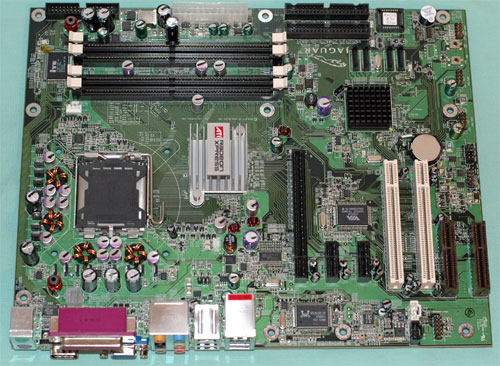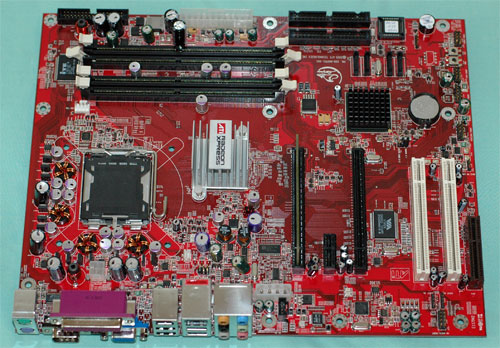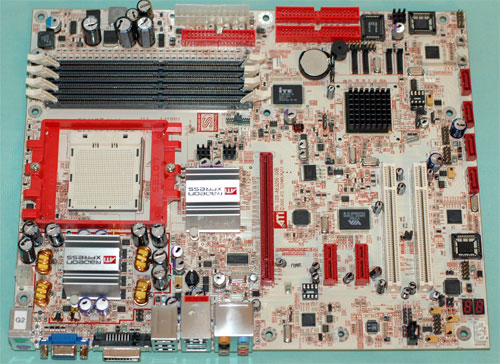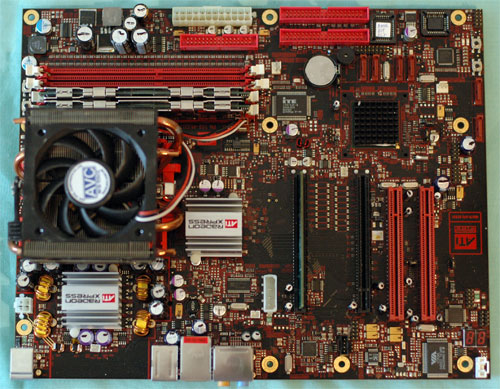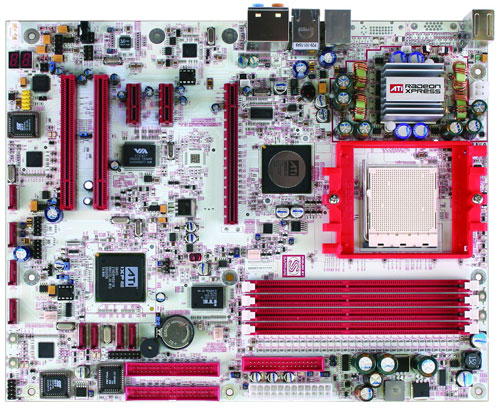
Original Link: https://www.anandtech.com/show/1743
Sapphire PURE Innovation - ATI's Chipset for the AMD Enthusiast
by Wesley Fink on July 29, 2005 12:05 AM EST- Posted in
- Motherboards
The talk of Computex was ATI's new Crossfire dual-video solution for AMD and Intel, but those of you who have been following ATI's chipset development realize the road to Crossfire has been a long one - and one that continues. When AnandTech looked at the introduction of RX480/RS480 chipsets for AMD last November, we found the performance of the new chipsets very impressive. ATI had done a particularly excellent job targeting the enthusiast for the new chipset launch, but that realization seemed to come late in the chipset development process. This meant that this excellent chipset was largely ignored by motherboard manufacturers who had already pegged the new ATI parts for Micro ATX integrated video parts for OEMs.
To ATI's credit, they have stayed the course of targeting the enthusiast, with a firm conviction that they could win the enthusiast with the right stuff, and that with the enthusiast would come penetration of the AMD market. Along the way, we have seen the original Bullhead board give way to today's Grouper (Sapphire PURE Innovation PI-A9RX480) and the upcoming Halibut (Crossfire AMD). Enthusiast-Level performance was an add-on for Bullhead, but Grouper and Halibut were designed from the ground up to satisfy the most demanding enthusiast.
The Intel side of the Radeon Xpress 200 came later, but ATI has also introduced, with little fanfare, the recent Jaguar board for Intel. This design will culminate in Stingray (Crossfire Intel), which ATI expects to introduce at the same time as Crossfire AMD. At that point, AMD and Intel will be equivalent ATI chipset options. While this chipset performance review talks about four main chipset solutions - AMD single GPU/Dual GPU and Intel Single GPU/Dual GPU - keep in mind that there are potentially 8 new chipset board combinations with the new ATI chipsets. There may also be an integrated graphics solution with any of these four combinations. Why would anyone want integrated graphics with this combination? Because you can run additional monitors simultaneously with the add-on graphics. This opens many interesting possibilities for multi-monitor solutions.
The Sapphire PURE Innovation is the first production Radeon Xpress 200 board that is clearly targeted at the AMD enthusiast, but there are other ATI Radeon Xpress 200 chipset boards on the way from Asus, MSI, DFI, ECS, Abit, TUL, ECS, and others. Our performance tests here are of the latest production Sapphire single-GPU RX480, but Sapphire and ATI tell us that performance of the Crossfire ATI should be exactly the same in single GPU mode. We will talk more about Jaguar/Crossfire Intel performance later in a Part 2 of this article. We also will ignore integrated graphics from a performance viewpoint, even though all options can provide integrated graphics if the necessary Radeon Xpress 200 north bridge is used. The integrated video solutions basically combine on-board ATI X300 graphics on either the AMD or Intel Radeon Xpress 200 chipset. You can read more about the performance of these integrated solutions in our review comparing ATI and Intel integrated graphics solutions.
Several days ago, we published benchmarks comparing Crossfire AMD to NVIDIA SLI and found Crossfire X850 XT to be very competitive with NVIDIA 6800 Ultra SLI - even with pre-release hardware and drivers. Today, we look more deeply at a production version of the ATI Grouper that will be launched by Sapphire next week. Grouper is the single GPU version of the Crossfire chipset, but it is otherwise identical to Crossfire AMD. The Sapphire PURE Innovation should perform as a chipset exactly the same as Crossfire AMD. How does Grouper perform compared to the best AMD chipsets on the market? What features will be available on ATI chipset boards? Of course, ATI has clearly targeted the AMD enthusiast with their new chipsets. With that in mind, the biggest question is whether or not the Sapphire Pure Innovation is worthy of consideration by AMD enthusiasts.
The ATI Xpress 200 Chipset Family
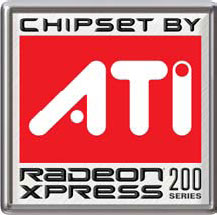
Last fall's introduction of the ATI AMD chipsets featured the SB400 south bridge. The Sapphire and upcoming Radeon Xpress 200 introductions combine the north bridge with the ATI SB450 south bridge, which features High Definition Azalia audio for both AMD and Intel. This is the first chipset to bring High Definition audio to AMD. The SB 450 also supports PCI-e Gigabit LAN, standard SATA 150, and has improved USB burst performance compared to the earlier SB400 chipset. We will see full SATA 2 support and a completely reworked USB controller in the SB600, which will launch in the 4th quarter of this year.
The various ATI Radeon Xpress 200 north bridges can also be combined with ULi south bridges. The current ULi 1573 provides all the features of the ATI SB450 except integrated Gigabit Ethernet. This includes High Definition Azalia audio. Gigabit Ethernet can be added as an external chip and the ULi 1573 also supports NCQ hard drives, which are not supported on the SB450, according to ATI.
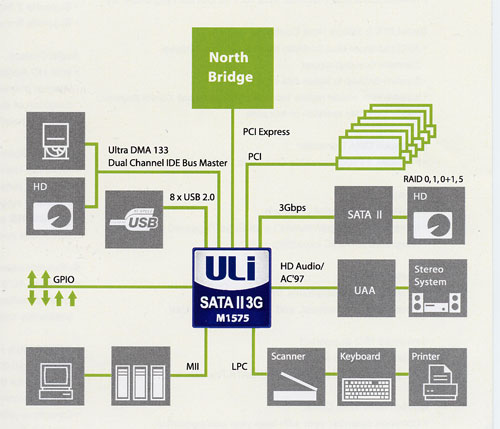
ATI Reference Boards
ATI's code name for the single-GPU slot Intel board is Jaguar.You will see Jaguar featured on single-GPU designs for Intel Socket 775.
The Dual-GPU version for Intel was developed with the Stingray code name.
Asus, Gigabyte, ECS, Abit, Sapphire, HIS and TUL will market Stingray as ATI Crossfire Intel.
The single GPU slot AMD solution is code-named Grouper.
The Grouper was an ATI design for Sapphire, and the Sapphire PURE Innovation evaluated in this review is basically the Grouper design. ATI tells us that several other manufacturers may also market similar single-GPU boards with a full range of overclocking controls to the enthusiast market.
The main focus of this Part 1 is the Sapphire PI-A9RX480, which is essentially the ATI Grouper Reference Board.
The Dual-GPU version for AMD is known by the code name of Halibut.
MSI, DFI, Gigabyte, Abit, ECS, Sapphire and TUL will market Halibut as ATI Crossfire AMD.
Sapphire PURE Innovation
Sapphire will release the first in their new PURE motherboard series around August 5th. The top enthusiast board, based on the Grouper Reference Board, will be the PURE Innovation. This is based on the discrete video version of the Radeon Xpress 200 chipset for AMD Athlon 64 Socket 939. There will also be another version based on the RS480 integrated graphics version of the same chipset.Sapphire and ATI have done an outstanding job of making the PURE ATI board stand out. This starts with silver foil Sapphire packaging...
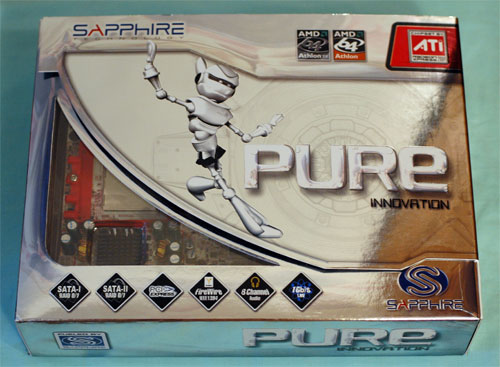
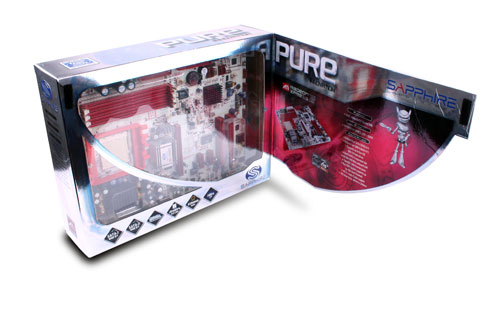
A white board in a window case with UV lighting should have the attention of those who like to show off their computer guts in a window case. This is certainly the first white motherboard that we have seen, and it is just another example of how Sapphire and ATI are out to get the attention of the AMD enthusiast. There is a lot to like that stands out in the appearance of the Sapphire, but most will be even more interested in the options available and how the board actually performs.
Basic Features: Sapphire PURE Innovation
| Sapphire PURE Innovation | |
| CPU Interface | Socket 939 Athlon 64 |
| Chipset | ATI RX480 Northbridge - ATI SB450 Southbridge |
| BUS Speeds | 200 to 440MHz in 1MHz Increments |
| Memory Speeds | DDR200, 266, 333, 366, 400 (433, 466, 500, 533 with Rev. E AMD) |
| PCIe Speeds | 100-200 |
| PCI/AGP | Fixed at 33/66 |
| Core Voltage | Auto, 0.8V to 1.55V in 0.025V increments PLUS .0V to 0.6V in 0.02V increments (Maximum vCore 2.15V) |
| CPU Clock Multiplier | 4x-25.5x in 0.5X increments |
| DRAM Voltage | Auto, 2.5V to 4.0V in .05V increments |
| HyperTransport Frequency | 1000MHz (1GHz) |
| HyperTransport Multiplier | Auto, 1X to 5X |
| HyperTransport Voltage | 1.22V, 1.29V, 1.39V, 1.5V |
| Xpress 200 Voltage | 1.22V, 1.29V, 1.39V, 1.5V |
| PCIe 1.2 Voltage | 1.22V, 1.29V, 1.39V, 1.5V |
| PCIe 1.8 Voltage | 1.8V, 1.9V |
| Memory Slots | Four 184-pin DDR DIMM Slots Dual-Channel Configuration Regular Unbuffered Memory to 4GB Total |
| Expansion Slots | 1 PCIe x16 2 PCIe x1 2 PCI Slots |
| Onboard SATA/RAID | 4 SATA Drives by SB450 (RAID 0, 1, JBOD) 2 SATA II Drives by Sil 3132 |
| Onboard IDE/IDE RAID | Two Standard ATA133/100/66 (4 drives) |
| Onboard USB 2.0/IEEE-1394 | 8 USB 2.0 ports supported by SB450 2 1394 Firewire by VIA VT6307 |
| Onboard LAN | Gigabit PCIe Ethernet by Marvel 88E8052 |
| Onboard Audio | Azalia HD Audio by Realtek ALC880 |
| BIOS Revision | Award (7/28/2005) |
The DFI nForce4 Ultra and SLI boards have quickly developed a reputation for offering the enthusiast every imaginable BIOS option. We mention the DFI only to put in perspective that the Sapphire ATI offers 2 more memory adjustments not found on the DFI and even more controls to tweak the performance of the motherboard. It is clear that ATI has worked with some leading enthusiasts in refining the Crossfire AMD - it clearly shows in the depth and breath of available options. At the other end of the spectrum, the Sapphire ATI also offers automatic overclocking options in the BIOS for those uncomfortable with manual overclocking
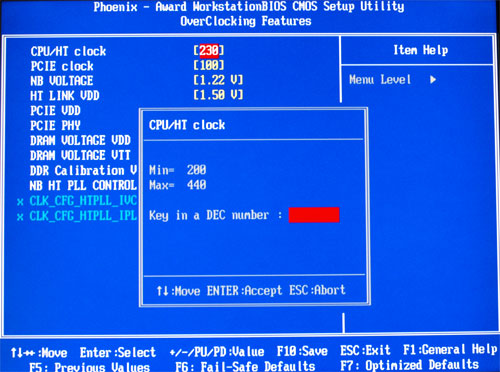
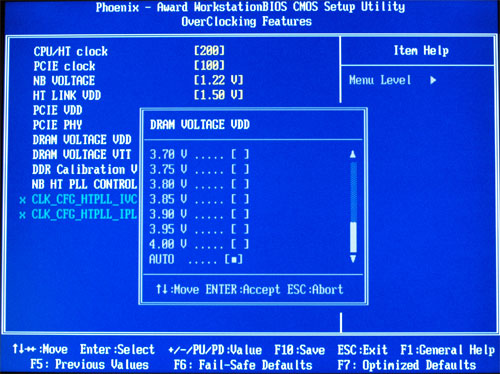
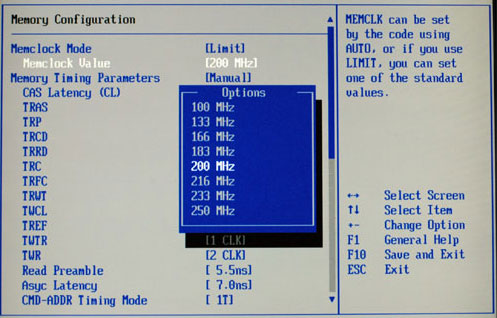
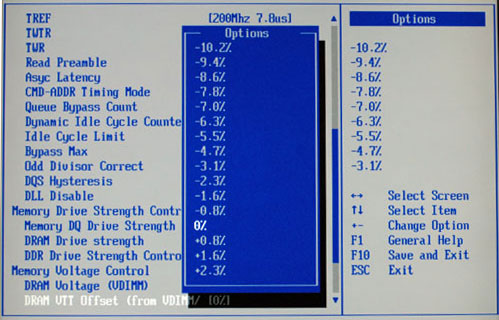

Overclocking: Sapphire PURE Innovation
| Sapphire PURE Innovation | |
| Overclocking Testbed | |
| Processor: | Athlon 64 4000+ (2.4GHz, 1MB Cache) |
| CPU Voltage: | 1.525V (default 1.50V) |
| Cooling: | Thermaltake Silent Boost K8 Heatsink/Fan |
| Power Supply: | OCZ Power Stream 520W |
| Memory: | OCZ PC3200 Platinum Rev. 2 (Samsung TCCD Memory Chips) |
| Hard Drive: | Seagate 120GB 7200RPM SATA 8MB Cache |
| Maximum OC: (Standard Ratio) |
245x12 (4x HT, 2.5-3-3-10) 2940MHz (+22.5%) |
| Maximum FSB: (Lower Ratio) |
302 x 9 (3x HT, 1T) (2718MHz, 2 DIMMs in DC mode) (+51% Bus Overclock) |
We have rarely tested a board with such incredible stability in overclocking as this Sapphire ATI. It was not always easy to reach our desired overclock with all of the exceptional range of options available in BIOS, but once we reached the overclock, it was extremely stable. We did notice that the Sapphire ATI responds best to gradual increases in overclocking - it does not like, for example, to be set directly to 245 clock frequency. It will reach higher overclocks if the Clock frequency is increased gradually instead of in one fell swoop.
The Sapphire ATI reached a new record with our standard 4000+ Clawhammer. The highest previous overclock at stock multiplier was 242, but the Grouper went on to a stable 245. This would be quite an accomplishment for any board, but it is remarkable for a first production board. The 302 Maximum bus frequency was also a great performance. ATI clearly set out to build an enthusiast board for Sapphire that other manufacturers could copy down to the smallest detail. Sapphire was smart enough to recognize a good thing when they saw it and they have faithfully reproduced the original Reference board. Our advice to most manufacturers developing ATI Radeon Xpress 200 designs would be to copy the Reference Design. Unless you are certain that you can extract even more performance from this chipset, it is best to copy the top-performing Xpress 200 Reference boards - whether single-GPU or Crossfire Dual-GPU.
At settings of 2T, we could reach even higher to a frequency of 320. There is a lot of discussion on the web these days, claiming that you can minimize the impact of the 2T setting with certain options on Revision E AMD processors. We did not verify this claim in our tests with an earlier standard Clawhammer processor, but we can tell you that all the talk about options for improving 2T performance modes are in the memory timings section. It is little touches like this that tell us that enthusiasts in ATI or Sapphire or outside the company have had a big hand in the design of the Radeon Xpress 200 family of chipsets.
tRAS and Memory Stress Testing
Memory tRAS Recommendations
In past reviews, memory bandwidth tests established that a tRAS setting of 11 or 12 was generally best for nForce2, a tRAS of 10 was optimal for the nForce3 chipset, and a tRAS of 7 was optimal for the nForce4 chipset. The recently tested ULi 1695 was best at tRAS of 10.Since this is our first review of a new ATI chipset, tRAS timings were first tested with memtest86, a free diagnostic program with its own boot OS that will boot from either a floppy disk or optical disk. Bandwidth of OCZ PC3200 Platinum Rev. 2, based on Samsung TCCD chips, was measured from tRAS 5 to tRAS 12 to determine the best setting.
| Memtest86 Bandwidth Sapphire PURE Innovation with Athlon 64 4000+ |
|
| 5 tRAS | 2048 |
| 6 tRAS | 2092 |
| 7 tRAS | 2141 |
| 8 tRAS | 2141 |
| 9 tRAS | 2092 |
| 10 tRAS | 2048 |
| 11 tRAS | 2004 |
| 12 tRAS | 1922 |
Two things stood out in our tRAS tests. First, the Sapphire ATI exhibits the best bandwidth at a tRAS setting of 7 or 8. We decided to use 7, since it is the same as the best setting for nForce4. Second, the bandwidth numbers on the ATI were a bit higher across the tRAS tests than what we saw with the ULi 1695. This suggests ATI having better optimized memory management - at least at this stage of development.
Memory Stress Test
Our memory stress test measures the ability of the Sapphire ATI to operate at its officially supported memory frequency (400MHz DDR), at the lowest memory timings that OCZ PC3200 Platinum Rev. 2 modules will support. All DIMMs used for stress testing were 512MB double-sided (or double-bank) memory. To make sure that memory performed properly in Dual-Channel mode, memory was only tested using either one dual-channel (2 DIMMs) or 2 dual-channels (4 DIMMs).| Stable DDR400 Timings - One Dual-Channel (2/4 DIMMs populated) |
|
| Clock Speed: | 200MHz |
| CAS Latency: | 2.0 |
| RAS to CAS Delay: | 2T |
| RAS Precharge: | 7T |
| Precharge Delay: | 2T |
| Command Rate: | 1T |
Using two DIMMs in Dual-Channel 128-bit mode, the memory performed in all benchmarks at the fastest 2-2-2-7 timings at default voltage, which was the only memory voltage available.
| Stable DDR400 Timings - 4 DIMMs (4/4 DIMMs populated) |
|
| Clock Speed: | 200MHz |
| CAS Latency: | 2.0 |
| RAS to CAS Delay: | 2T |
| RAS Precharge: | 7T |
| Precharge Delay: | 2T |
| Command Rate: | 2T |
Tests with all four DIMM slots populated on the Sapphire required a 2T Command Rate with 4 DIMMs in two dual channels. This is the pattern seen on other top-performing Socket 939 boards. The Sapphire AMD had no problem running at a 200 CPU speed setting with 4 double-sided DIMMs. Since the Athlon 64 memory controller is on the processor, there were no real surprises in the memory stress tests. The Sapphire ATI is certainly competitive with the best Socket 939 boards in memory performance.
Test Setup
| Performance Test Configuration | |
| Processor(s): | AMD Athlon 64 4000+ (2.4GHz) Socket 939 |
| RAM: | 2 x 512MB OCZ PC3200 Platinum Rev. 2 |
| Hard Drive(s): | Seagate 120GB 7200 RPM SATA (8MB Buffer) |
| Video AGP & IDE Bus Master Drivers: | ATI Catalyst Platform 5.7 |
| Video Cards: | ATI X850XT PE NVIDIA 6800 Ultra MSI NVIDIA 7800GTX |
| Video Drivers: | ATI Catalyst 5.7 NVIDIA nForce 77.79 |
| Operating System(s): | Windows XP Professional SP2 Direct X 9.0c |
| Motherboards: | Sapphire PURE Innovation (ATI RX480/SB450) ULi AP9567A (M1695/M1567) Abit An8 Fatal1ty Biostar NF4UL-A9 Chaintech VNF4-Ultra DFI LANParty UT nF4 Ultra-D ECS KN1 Extreme Epox 9NPA+ Ultra Winfast NF4UK8AA (Foxconn) Asus A8N-SLI Deluxe DFI LANParty nF4 SLI-DR Gigabyte K8NXP-SLI MSI K8N Neo4/SLI Platinum |
Tests used OCZ PC3200 Platinum Rev. 2, which uses Samsung TCCD chips. All memory ran at 2-2-2-7 timing in all benchmarks.
We tested with our standard NVIDIA 6800 Ultra to allow the best comparisons to benchmark results with other motherboards. To demonstrate performance with various current video options, we also tested with the ATI X850XT PE and the MSI NVIDIA 7800GTX. Resolution in all benchmarks is 1280x1024x32 unless otherwise noted.
Results for the Sapphire ATI with the ATI X850 XT PE are color-coded red in all graphs; results for the Sapphire ATI/NVIDIA 6800 Ultra are in orange; and, Sapphire ATI/MSI NVIDIA 7800 GTX are in gold. Results for the other boards, all tested with the NVIDIA 6800 Ultra, are color-coded blue.
General Performance
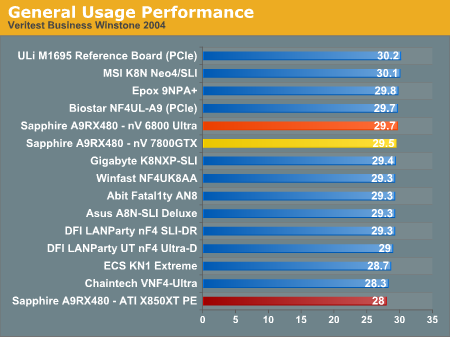
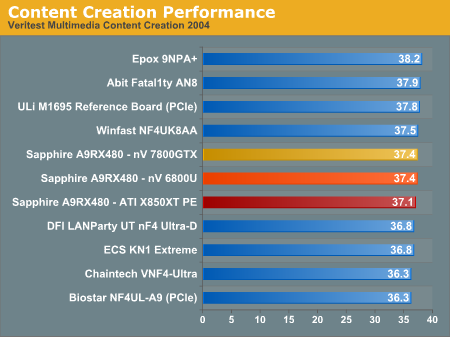
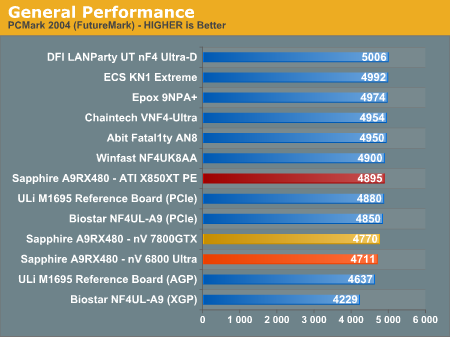
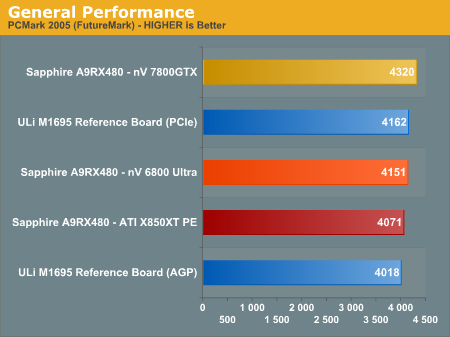
It should come as no surprise that high performance video has little impact on Winstone performance. Whether the top ATI card, the comparable NVIDIA 6800 Ultra, or the latest NVIDIA 7800GTX, Business Winstone 2004 and Content Creation 2004 results are pretty much the same at the same CPU speed. The lone exception is the 1.5 to 2 point boost given to Business Winstone 2004 by NVIDIA video cards. We have commented on this before, but still cannot explain why NVIDIA cards perform better in Business Winstone. This is most clearly demonstrated when you compare performance of the ATI X850XT PE at 28 to the NVIDIA 6800 Ultra and 7800GTX at about 2 points higher.
PCMark 2004 appears to slightly favor ATI video cards in their performance score, while the newest PCMark 2005 seems to be the opposite - providing better results for the NVIDIA 6800 Ultra with the 7800GTX with a substantial lead in the PCMark 2005 score.
There is little to distinguish or detract from the Sapphire ATI in General Performance benchmarks. The Sapphire board is competitive with the best Socket 939 Athlon 64 boards that we have tested.
Graphics Performance and Encoding
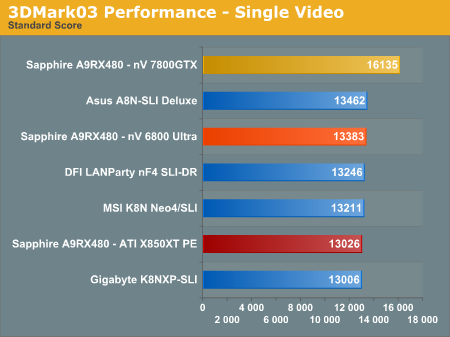
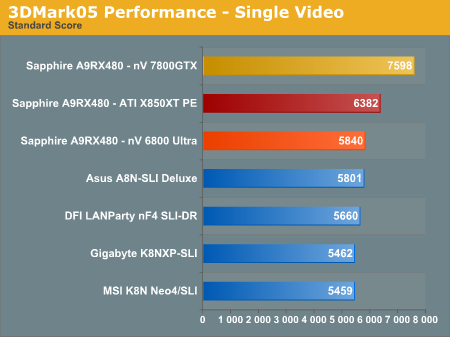

The 3DMark graphics Benchmarks from FutureMark show performance much as we expected. That is, the latest and fastest NVIDIA 7800GTX has a substantial lead over the ATI X850XT PE and the similar performing NVIDIA 6800 Ultra. 3DMark05, the latest Graphics Mark, also shows a comfortable performance lead for the ATI X850XT PE over the NVIDIA 6800 Ultra.
It is perhaps more interesting that the rest of our benchmarks don't reflect the same kind of domination by the 7800GTX that you might expect after looking at the 03 and 05 test results. This is just another example of benchmarks that are sensitive measurements of one parameter, like graphics performance, and may not be the best gauge of overall performance.
It has often been pointed out that encoding results should not be affected by the graphics card used during the encoding benchmarks. This is clearly demonstrated by the 17 test results for AutoGK using an AMD 4000+ processor with a wide assortment of other components. The performance range of those 17 encoding tests is just 47.9 to 49.3 - a difference from high to low of just 1.4 frames.
Gaming Performance
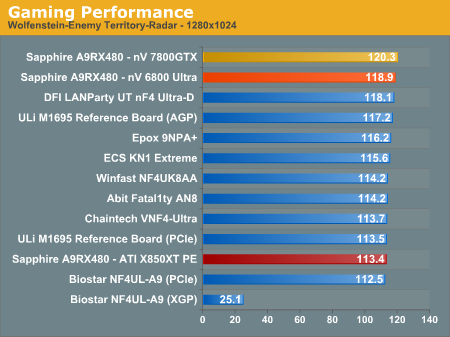

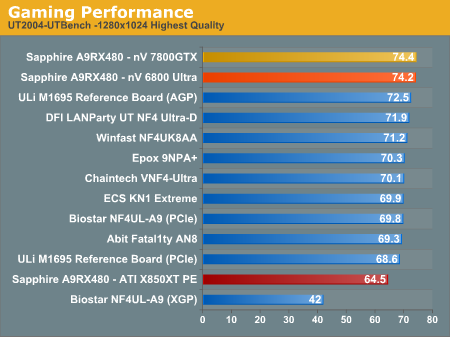
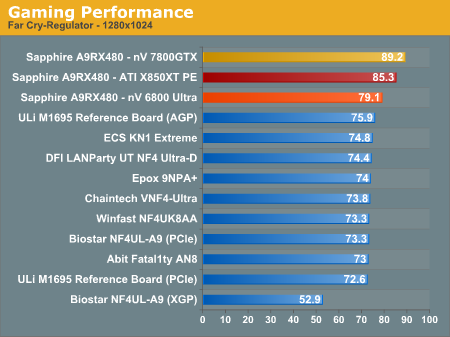
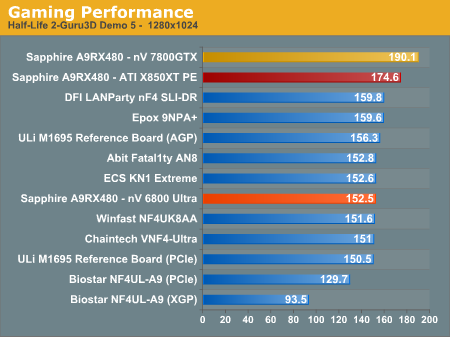
If you keep in mind that the orange bar represents the same NVIDIA 6800 Ultra used to test the other boards in this review, you can clearly see that the Sapphire ATI is at or near the top in most game tests. The Sapphire ATI chipset performs at least as fast as the best of nForce4 chipset boards. This is a significant accomplishment for ATI, since there are no glaring performance weaknesses that would tilt the buying decision to a competitor's board.
You can also see that the Sapphire ATI performs very well when driving an NVIDIA 7800GTX video card. You may be surprised to see such a relatively small advantage for the 7800GTX in many of our gaming benchmarks, but that is a result of screen resolution. We run all benchmarks at 1280x1024, which is the highest resolution available on the most used 19" and smaller flat panels. The 7800GTX pulls away only when all the eye candy is turned on or at even higher resolutions. The point of this is that unless you have a 20" or larger LCD (or you're happy with a high-res CRT), the 7800GTX may be a wasted expense that will bring you little additional performance for what the added cost.
Overclocking
Maximum overclock data was added to Performance graphs beginning with the nForce4 SLI roundup several months ago. The overclocking performance graphs should allow for better comparison of the overclocking capabilities of tested boards. For more details on the specific overclocking abilities of a specific board, please refer to the Overclocking and Memory Stress Test section of individual board reviews. Since the Sapphire PURE Innovation and the dual GPU slot ATI Crossfire AMD are based on the same chipset, performance should be very similar and directly comparable.
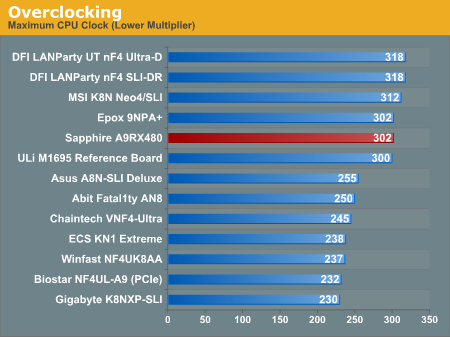
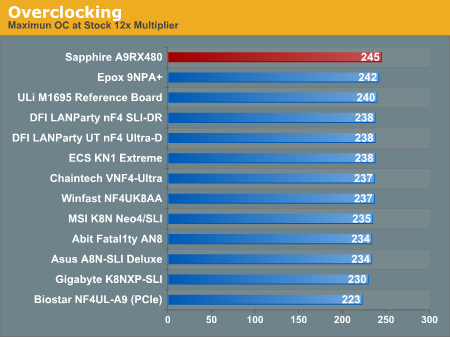
The overclocking performance of the Sapphire PURE Innovation was impressive to say the least. A 245 Clock Frequency at stock multiplier is the highest overclock that we have ever seen with this reference processor. Reaching 245 when the best boards that we have tested did 238 and 240 is a strong indication of excellent voltage stability under stress in the Sapphire.
302 at lower multipliers is not the highest value that we have reached in past testing, but it does place the Sapphire ATI in the company of the few excellent overclocking Athlon 64 boards that have managed to reach a stable 50% or better frequency overclock at lower ratios.
ATI has made tremendous progress in board design, since we looked at the initial Bullhead board last November. In this Sapphire for AMD and the upcoming Crossfire AMD, ATI has produced motherboards that will definitely please the AMD enthusiast.
Disk Controller Performance
With so many chipsets and brands of storage controllers on current Athlon 64 boards, we needed a means of comparing performance of the wide variety of controllers. The logical choice was Anand's storage benchmark first described in Q2 2004 Desktop Hard Drive Comparison: WD Raptor vs the World. To refresh your memory, the iPeak test was designed to measure "pure" hard disk performance, and in this case, we kept the hard drive as consistent as possible while varying the hard drive controller. The idea is to measure the performance of a hard drive controller with a consistent hard drive. We played back Anand's raw files that recorded I/O operations when running a real world benchmark - the entire Winstone 2004 suite. Intel's IPEAK utility was then used to play back the trace of all the IO operations that take place during a single run of Business Winstone 2004 and MCC Winstone 2004. To try to isolate performance difference to the controllers that we were testing, we used Seagate 7200.7 model SATA and IDE hard drives for all tests.iPeak gives a mean service time in milliseconds; in other words, the average time that each drive took to fulfill each IO operation. In order to make the data more understandable, we report the scores as an average number of IO operations per second so that higher scores translate into better performance. This number is meaningless as far as hard disk performance is concerned as it is just the number of IO operations completed in a second. However, the scores are useful for comparing "pure" performance of the storage controllers in this case.

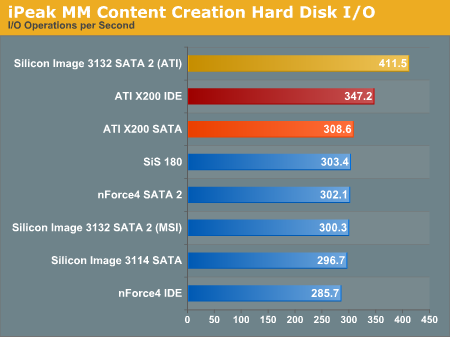
The Sapphire PURE Innovation is a really excellent performer in iPeak tests. The new SB450 turned in some of the highest iPeak measurements that we have yet seen in IDE and on-board SATA. While the SATA controller of the SB450 is not the SATA 2 used by the NVIDIA nForce4, its performance is even faster than nF4 when running our stock SATA drive.
In past benchmarking, IDE has provided the slowest IO performance in this roundup. However, ATI IDE breaks that trend, with IDE performance to be the best that we have measured since we have been testing with iPeak.
Sapphire and ATI have also done an excellent job in implementing the Silicon Image 3132 chipset for SATA 2 performance. The 3132 was blazing fast in our benchmarks, setting new iPeak performance records. For disk storage - IDE, SATA, or SATA 2 (with the Sil3132) - the Sapphire ATI delivers outstanding storage performance.
Firewire and USB Performance
It is really difficult to put together a simple, repeatable, and consistent test to measure USB and Firewire Performance. Since our goal was to make this a standard part of motherboard testing, we needed a benchmark that was reasonably simple to run that would also provide consistent results on the same test bed. We finally determined that an external USB 2.0, Firewire 400, and Firewire 800 hard disk might be a sensible way to look at USB and Firewire throughput.Our first efforts at testing with an IDE or SATA drive as the "server" yielded very inconsistent results, since Windows XP sets up cache schemes to improve performance. Finally, we decided to try a RAM disk as our "server", since memory removed almost all overhead from the serving end. We also managed to turn off disk caching on the USB and Firewire side by setting up the drives for "quick disconnect" and our results were then consistent over many test runs.
We used just 1GB of fast 2-2-2 system memory set up as a 450MB RAM disk and 550MB of system memory. Our stock file was the SPECviewPerf install file, which is 432,533,504 bytes (412.4961MB). After copying this file to our RAM disk, we measured the time for writing from the RAM disk to our external USB 2.0 or Firewire 400 or Firewire 800 drive using a Windows timing program written for AnandTech by our own Jason Clark. The copy times in seconds were then converted into Megabits per second (Mb) to provide a convenient means of comparing throughput. Higher Rates, therefore, mean better performance.
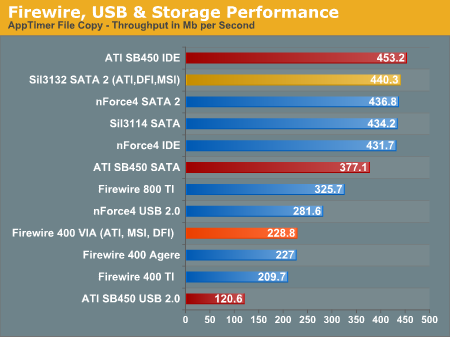
Sapphire PURE Innovation uses the commonly available and good-performing VIA Firewire 400 chip. Firewire 800 is 40 to 55% faster than a drive connected to Firewire 400, but it is still rare to find Firewire 800 integrated into motherboards.
Perhaps the biggest surprise in our testing was the poor performance of USB 2.0 on the Sapphire ATI. ATI had promised improvement in USB performance in the SB450 compared to the earlier SB400, but we could see little improvement in our USB 2.0 tests. ATI has responded that our USB 2.0 tests measure sustained throughput, which is relevant in USB operations only with applications like the USB 2.0 hard drive that we use for this test. ATI states that "burst" USB 2.0 throughput has been improved in the SB450 to near the same levels of competitive USB 2.0 peak performance. Perhaps even more important, ATI say that they are aware of the issues with USB 2.0 performance and these will be fully corrected - sustained and peak performance - in the SB600 south bridge.
Since our ramdisk/apptimer File Copy is measuring sustained throughput, we also compared performance of ATI IDE/SATA/Sil SATA2 using this same test procedure. The performance of ATI IDE remains excellent, but SATA and SATA 2 performance are very competitive, yet not standout as in the iPeak storage benchmarks of the same controllers. This lends some credibility to ATI's comments that their USB 2.0 performance is competitive when burst performance is measured.
Ethernet Performance
The new motherboard test suite, launched earlier this year, includes LAN performance measurements. The test procedure that we use was first described in a VIA white paper.The Windows 2000 Driver Development Kit (DDK) includes a useful LAN testing utility called NTttcp. We used the NTttcp tool to test Ethernet throughput and the CPU utilization of the various Ethernet Controllers used on the nForce4 Ultra motherboards.
We set up one machine as the server; in this case, an Intel box with an Intel CSA Gigabit LAN connection. Intel CSA has a reputation for providing fast throughput and this seemed to be a reasonable choice to serve our Gigabit LAN clients. At the server side, we used the following Command Line as suggested by the VIA whitepaper on LAN testing:
Nttcps - m 4,0,On the client side (the motherboard under test), we used the following Command Line:-a 4 - l 256000 - n 30000
Nttcpr - m 4,0,At the conclusion of the test, we captured the throughput and CPU utilization figures from the client screen.-a 4 - l 256000 - n 30000
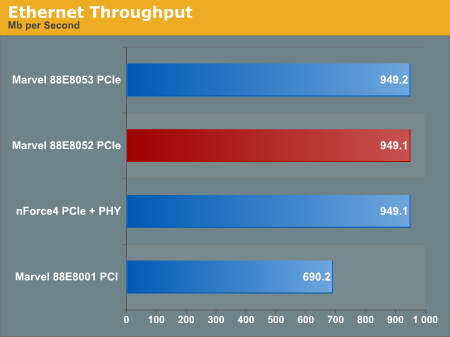

CPU utilization measurements for Gigabit Ethernet can be somewhat misleading, since they measure the percentage of CPU tie-up at sustained Gigabit receiving. In reality, it would be very rare that you would actually see sustained Gigabit transmission levels on your PC. For that reason, you should put the measured CPU utilization of Gigabit PCIe LAN in perspective. It will almost always be much lower than what we have measured.
Audio Performance
For audio testing, we used Rightmark 3D Sound CPU utilization test, which is the same benchmark run in our earlier nForce4 SLI and Ultra roundups. This benchmark measures the overhead or CPU utilization required by a codec or hardware audio chip.
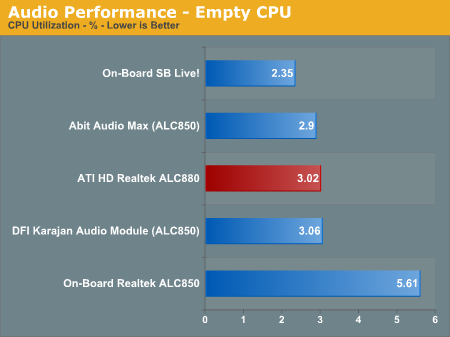
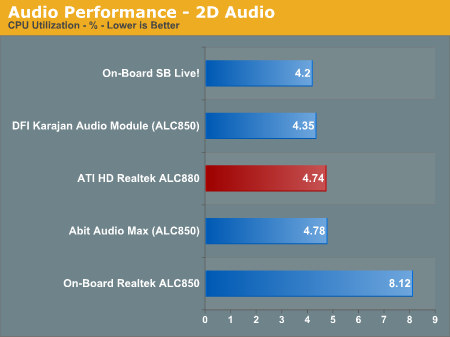
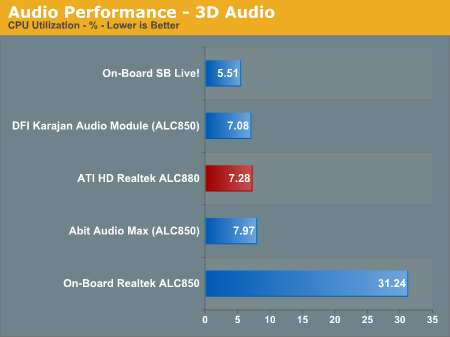
It is very important to point out that the ATI Crossfire AMD is the first Athlon 64 board to deliver Azalia High Definition audio. Those who have been complaining about the poor AC'97 audio present on most AMD boards should be very pleased to find Azalia HD on the ATI.
We did some subjective listening tests with the ATI Azalia HD through a Dolby amplifier and a 5.1 speaker setup. The ATI Azalia HD was in a completely different league from the other audio solutions that we have tested on Athlon 64. Noise was virtually nonexistent, and the imaging and depth were superb when listening to Orff's Carmina Burana. The same CD sounded thin, noisy, and artificial through a more common ALC850 fed to the same Dolby amp and 5.1 speakers. This is not to say that the Azalia HD is at the same level as the very best audio cards, but it is a lot closer than what we think many of you imagine.
As the first implementation of Azalia HD audio on A64, the HD Realtek ALC880 features:
- High-performance DACs with 100dB S/N ratio
- ADCs with S/N ratio greater than 85dB
- Meets performance requirements for audio on PC2001 systems
- 8 DAC channels support 16/20/24-bit PCM format for 7.1 audio solution
- 3 stereo ADCs support 16/20-bit PCM format, two for microphone array, one for legacy mixer recording
- Supports 44.1K/48K/96K/192kHz DAC sample rate
- All ADCs support 44.1K/48K/96K sample rate
- Applicable for 4-channel/192kHz and 6-channel/96kHz DVD-Audio solutions
- Up to four channels of microphone input are supported for AEC/BF application
- High-quality differential CD input
- Supports Power Off CD function
- Supports external PCBEEP input and built-in BEEP generator
- PCBEEP Pass-Through when link is in RESET state
- Software selectable 2.5V/3.75V VREFOUT
- Six VREFOUTs are supported by default, with additional four VREFOUTs available by sharing unused analog I/O pins
- Two GPI (General Purpose Input) jack detection pins (each designed to detect 4 jacks)
- 16/20/24-bit S/PDIF-OUT supports 44.1K/48K/96kHz sample rate
- 16/20/24-bit S/PDIF-IN supports 44.1K/48K/96kHz sample rate
- Optional EAPD (External Amplifier Power Down) supported
- Power support: Digital: 3.3V; Analog: 3.3V/5.0V
- Power management and enhanced power saving features
- Compatible with AC'97
- 48-pin LQFP package (lead-free package also available)
- Reserve analog mixer architecture for backward compatibility with AC'97
- -64dB ~ +30dB with 1dB resolution of mixer gain to achieve finer volume control
- Impedance sensing capability for each re-tasking jack
- All analog jacks are stereo input and output re-tasking for analog plug & play
- Built-in headphone amplifier for each re-tasking jack
- Supports external volume knob control
- Supports 2 GPIOs (General Purpose Input/Output) for customized applications
- Hardware de-scrambling for DVD-Audio Content protection
- Meets Microsoft WHQL/WLP 2.0 audio requirements
- EAXTM 1.0 & 2.0 compatible
- Direct Sound 3DTM compatible
- A3DTM compatible
- I3DL2 compatible
- HRTF 3D Positional Audio
- Emulation of 26 sound environments to enhance gaming experience
- 10 Software Equalizer Bands
- Voice Cancellation and Key Shifting in Karaoke mode
- Realtek Media Player
- Enhanced Configuration Panel and device sensing wizard to improve user experience
- Microphone Acoustic Echo Cancellation (AEC) and Beam Forming (BF) technology for voice application
- Mono/Stereo Microphone noise suppression
- ALC880D features Dolby® Digital Live output for consumer equipment
Final Words
In every benchmark at stock speeds, we found the Sapphire PURE Innovation board for AMD to be fully competitive with the best motherboards that we have tested for Athlon 64 Socket 939. As you saw in last week's preview of Crossfire Multi-GPU performance, it also appears that Crossfire will compete very effectively with NVIDIA SLI in the Dual-Graphics arena as well. So, what tips the scales toward the new ATI chipset boards or the nForce4 boards or ULi?One area would be features. ATI's performance in IDE, SATA, and SATA2 (with the Sil3132) is exemplary. We have often seen new chipsets where storage performance is much worse than the current best. Considering the newest versions of the ATI Radeon Xpress X200 family with the SB450 South Bridge, this certainly does not appear to be the case. Storage performance is excellent compared to any of the leaders.
One glaring performance exception for the ATI SB450 is USB 2.0. We expected ATI USB performance to be on par with the competition by this point, but it still lags in sustained throughput. ATI tells us that the SB450 performance is comparable to competitors in burst mode and will be completely corrected in the SB600, but that south bridge is still months away. We doubt that most users will ever see a real difference in USB performance with the Sapphire PURE Innovation or the upcoming ATI Crossfire AMD, but if USB performance is critical to your use, you should look elsewhere. Either the nForce4, the ATI Radeon Xpress 200 north bridge with a ULi 1573 or 1575 siouth bridge, or a ULi chipset should perform fine in USB 2.0.
Offsetting USB, the ATI is the first AMD chipset to market with Azalia High-Definition audio. Azalia HD exhibited low overhead in all audio modes, and most important, the sound quality is stunning compared to the majority of audio codecs currently residing on AMD motherboards. If on-board audio performance matters to you, you should definitely audition an ATI HD board. It should be mentioned that both the ULi 1573 and the 1575 south bridges will also feature HD audio.
If you want to use your AGP card, then the upcoming ULi M1695/M1567 chipset is the only real choice for performance.
So, with pluses and minuses in several areas for each chipset, are there other factors that should influence your decision? If you are an enthusiast, then the answer is a resounding "YES". Sapphire and ATI have designed Grouper and Crossfire from the ground up as enthusiast boards. The Reference boards are the best and most stable that we have ever tested from an overclocker's perspective, and the production Sapphire PURE Innovation is just as overclockable and stable as the outstanding Reference Boards that we have seen. This design and component excellence has certainly made its way into this first Sapphire production board, and it should make its way into other upcoming production boards. Reference boards always heavily influence the product that makes it out the door, and in this case, that is outstanding news.
The Sapphire PURE Innovation reached the highest overclock at stock multiplier ever achieved with our standard 4000+ processor. We also easily reached a 302 frequency at lower multipliers at a 1T command Rate. The bottom line is that this production Sapphire board will turn the head of enthusiasts. The appearance is stand-out (a white motherboard) and the performance will not need to make apologies to any Athlon 64 board on the market. Other manufacturers who are known for making enthusiast boards have already committed to producing an ATI Crossfire board - AMD or Intel or both. Some may also produce a single-GPU board like this Sapphire PURE Innovation PI-A9RX480. Whatever they produce, it is clear that this time around the latest ATI Radeon Express 200 family chipsets will be seen on many top-end motherboards. If they are close to as good as this Sapphire ATI, it will be a good time to be an enthusiast.
We've waited a long time for a real competitor to NVIDIA that would keep prices in line as only real competition can. ATI announced aggressive pricing strategies with their new Crossfire chipsets and nF4 SLI prices are already slated to drop. With Crossfire and SLI both performing well, the buyer is the winner. It means that you will get the best performance possible at the best price possible from either ATI or NVIDIA. If you are also an enthusiast, you also have a new and unexpected board to add to your short shopping list for a top Athlon 64 board. The Sapphire PURE Innovation deserves your consideration as a top enthusiast board. ATI and Sapphire deserve praise for having the guts to bring this board to market.
Since Crossfire was designed to reach these same lofty levels of performance, you can also expect that some new and exciting choices will be coming in the Dual-GPU segment. But it is also interesting that the new top video cards like the NVIDIA 7800 GTX and upcoming ATI R520 perform extremely well as single cards, requiring impossibly expensive monitors for usable performance gains in dual-GPU mode. Those developments may well make boards like the Sapphire PURE Innovation even more attractive with the newest generation of video cards.

